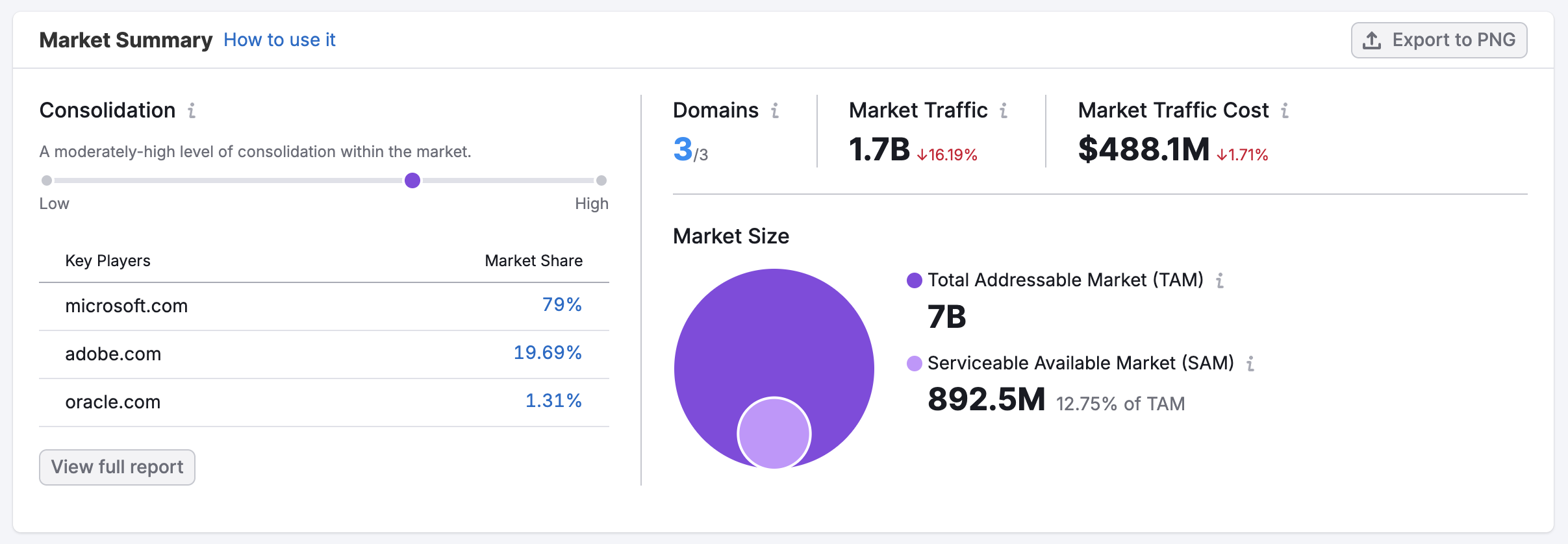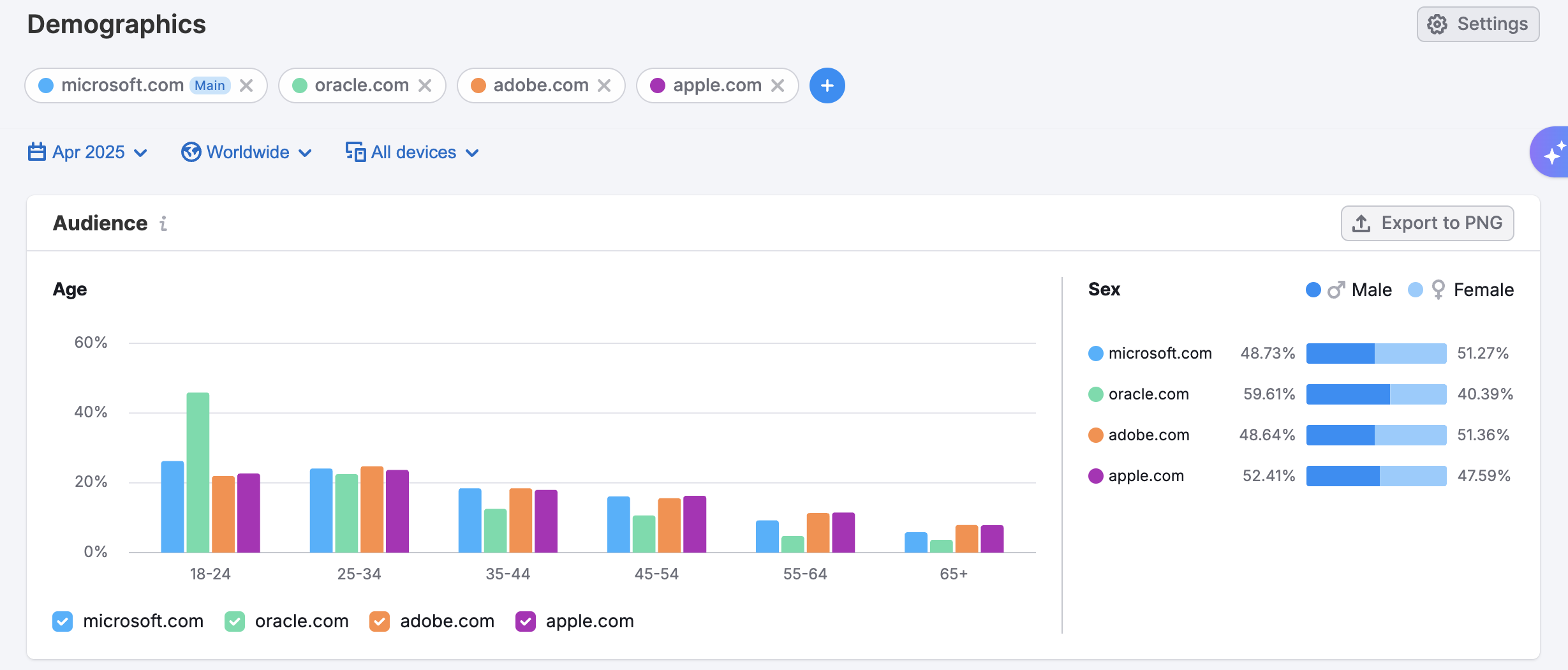This post gives you a clear and practical framework for performing a market analysis.
We first start with the basics. Then move on to discuss the exact steps you need to take to analyze any market.
Let’s start.
What is a market analysis?
A market analysis is the process of learning everything you can about your target market. It’s like doing your homework to prepare before launching and growing your business.
And performing a market analysis has many benefits. For example:
- You can estimate your market’s total size and potential. To determine if your business will be viable and profitable.
- You can identify your target customers and their needs and preferences. So you can develop the right marketing strategy to attract them.
- You can analyze your competitors and their strategies. So you can formulate plans to surpass them and grow your market share.
In short, a market analysis helps you grow your business faster and smarter.
But how do you perform a market analysis? And what are the best tools and methods to be used?
Let’s find out.
How to do a market analysis
Follow our seven-step process to analyze any market.
1. Determine the purpose of your analysis
Take a moment to ask yourself why you are doing this analysis.
Is it because you launch a new product and need to evaluate the entire market landscape?
Or maybe you’ve already launched your product, but are now looking to find the best channels for marketing.
Your purpose can be related to everything you want to learn about. And it will shape your entire analysis.
Here’s the best way to nail your purpose:
- Grab a pen and paper (or open a new Google Doc)
- Write why you want to conduct a market analysis. Don’t overwhelm it – just write what pops in your head.
For example:
You are doing a market analysis to launch a new accounting software. And your goal is to find answers to these questions:
- How big is the accounting market and is there a business opportunity?
- Who are your ideal customers and what are their unique features?
- Who are the existing players in the market and how do they place themselves?
- What are the best ways to reach and attract your potential customers?
Based on the analysis, you decide the best way to start and grow your business.
2. Examine your market’s total landscape
Now that you are aware of why you are doing a market analysis, it’s time to get a bird’s eye view in your market using a market research tool. And collect information such as market size, competitors, opportunities, etc.
Use Market overview in Traffic and market tool set to this.
Open the tool and enter the domains you wish to investigate.
Then select the time frame and region from the drop -down menus.
You get an overview of high level that touches:
- Consolidation: A low consolidation level means there are many smaller businesses on the market and you have a good opportunity to enter this space
- Market traffic: The total amount of potential site traffic in your market. The higher this number, the better.
- Market size: The total number of potential buyers in your market

Remember:
You are not deep in detail at this time.
You get a high level of your industry. To better understand its dynamics and how your business could fit into this larger image.
We do an in -depth analysis of these competitors in the next step.
3. Analyze the competition
A large part of performing a market analysis is to study your competitors.
Having a deep understanding of your competitors’ product offering, pricing and marketing tactics helps you see holes in your market and promote your products effectively.
How to analyze your competitors:
First visit their sites.
Learn about what products or services they offer and how they place them. And look for holes or areas where your product could provide unique value.
Secondly, look at their pricing. This gives you an idea of how to compare with similar products or services in the market.
And thirdly, find out what marketing channels competitors are using. If certain channels already work well for your competitors, they probably work for you too.
Use Traffic & MarkeT.‘p Traffic overview Tool to see which marketing channels your competitors are using.
Open the tool and enter the domains you want to analyze. Then use the drop -down menus to filter by time frame, frequency, region and device type.

The “Traffic Channel Distribution” map reveals which marketing channels are driving the most traffic to your competitor’s website.

If most traffic comes from “direct”, this brand is probably focused on branding and traditional advertising.
But if you see a significant part of traffic coming from organic search, it indicates that they have a strong SEO strategy in place.
And if E -Mail is an important source, it is clear that they are utilizing E -mail marketing effectively.
This information is good for your market analysis. So use this data to prioritize your own marketing channels.
4. Get to know your target audience
The next step is to focus on people who really matter – your target audience.
Successful companies solve a problem for someone. Your job is to find out who is anyone. Begin to learn more with Demographics Dashboard.
This gives you all the information you need to better understand your target audience.
Open Demographics and enter at least one competitor’s web site.

The Demography Dashboard Data gives you an idea of the language and references you need in your marketing material. For example, if your audience is predominantly millennia, there are women who let you know what types of examples will be most relevant to them.
Understanding these audience characteristics helps you tailor your marketing.
The more you know about your audience, the better you can market your product.
5. Get deeper insight into your audience needs and preferences
Now that you understand who your target audience is, it’s time to dig deeper into their needs and preferences. So you can place your product or service as the perfect solution for them.
There are a few ways to reveal your audience needs:
- Online studies: Create a short study that asks people about their needs and preferences. Offer an incentive to participate and distribute it through organic social or even paid ads. You can use tools such as SurveyMonkey or Type Form to create studies.
- Focus groups: Gather six to eight people from your target audience and moderate a discussion about their needs. Seeing them interacting provides qualitative data, no tools can give you.
Once you’ve collected all this data, look for common themes to identify your audience’s core needs.
For example, if you still hear they want more flexibility or convenience, these are problems your product should solve.
This information also allows you to tailor your messages. By including their desired benefits prominently in your marketing copy.
The more you can place your business as the answer your audience needs, the better.
6. Complete a SWOT -Analysis
After examining the overall market, competitors and target audience change your attention inward by performing a SWOT analysis – a technique that helps you evaluate your own strengths, weaknesses, opportunities and threats in relation to your market.
It can help you identify what makes you stand out from your competitors, what areas you need to improve, what opportunities you can pursue, and what risks you need to avoid.
To perform a SWOT analysis, ask yourself some questions about each of the four categories:
- Strengths: What are your benefits? What are you doing good or better than others? What unique resources or capabilities do you have?
- Weaknesses: What are your disadvantages? What do you need to improve or avoid? What are gaps or limitations in your resources or capabilities?
- Opportunities: What are the favorable trends or conditions in your market? What are your customers’ unmet needs or problems? What new or new technologies can you take advantage of?
- Threats: What are the unfavorable trends or conditions in your market? What are the challenges or obstacles you face? What new or existing competitors threaten your position?
Identifying market trends is extremely advantageous to perform a SWOT analysis. Which you can do by talking to experts in your niche, attending conferences and studying industry reports such as those from Ibisworld, Statista and Industry-specific publications.
Then you can organize your answers in a table like this:
|
Strengths |
Weaknesses |
|
– First example of strength |
– First example weakness |
|
– Other example of strength |
– Other example weakness |
|
– Third example of strength |
– Third Example Weakness |
|
Opportunities |
Threats |
|
– First example |
– First example threat |
|
– Other example option |
– Other example threat |
|
– Third example |
– Third example threat |
This step can help you gain insight into your market and your competitiveness.
You can use it to develop strategies that utilize your strengths, address your weaknesses, exploit your opportunities and mitigate your threats.
7. Put your findings at work
Take everything you learned from the research you have done and apply it to your business.
The goal of a market analysis is not only to collect data – it is to use this data to make smarter decisions to grow your business.
Here are a few ways you can do it:
- Refine your unique sales proposal (USP): Use what you’ve learned about your competition to sharpen your USP. Did you uncover a feature that your competition does not offer? Maybe it’s worth highlighting on your site and in your marketing material.
- Improve your marketing channel mix: Use your insight on where your audience spends time online and what marketing channels your competition uses to better reach potential customers. It’s about reaching the right people in the right place with the right message.
- Lessen risks: Take advantage of your SWOT analysis to anticipate challenges and build emergency plans. By recognizing your company’s threats and weaknesses, you can create a strategy that includes ways to overcome these obstacles before they even become problems.
- Grab options: Use the trends you have identified to keep you in front of the curve. If you have seen new technologies or shifts in consumer behavior, consider how to customize your product or service offerings to adapt to them.
And remember this:
Performing a market analysis is not a one -time exercise.
Your market is always changing. So you have to regularly monitor it to remain competitive.
Do your first market analysis
Now that you know how to do a market analysis, take the next step and try it yourself.
It’s not rocket science. With the right tools and frames, anyone can do it.
And Semrush has a package of market analysis tools that can help you through almost every step involved in performing a market analysis.
Sign up today.
